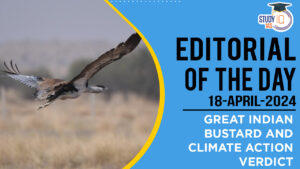Daily Current Affairs for UPSC 2023
Q) Which of the following is correct about Sovereign Green Bonds (SGrBs)?
- The funds raised will be deposited in the Public Account of India.
- SGrBs were first announced in Union Budget 2021–22.
- The Reserve Bank of India will conduct SGrB’s auction.
- Ministry of Finance will monitor allocation of funds for SGrBs.
Daily Current Affairs for UPSC – 25 January 2023
Explanation:
- Option (1) is incorrect: Sovereign Green Bonds are bonds issued by a sovereign entity, inter-governmental groups or alliances and corporations with the aim that the proceeds of the bonds are utilised for projects classified as environmentally sustainable. The funds raised through the issuance of green bonds will be deposited in the Consolidated Fund of India (CFI). India stands committed to reducing the emissions intensity of GDP by 45% from the 2005 level by 2030 and achieving about 50% cumulative electric power installed capacity from non-fossil fuel-based energy resources by 2030.
- Option (2) is incorrect: Union Budget 2022-23 made an announcement to issue Sovereign Green Bonds to significantly reduce the carbon intensity of the economy. The government will use the proceeds raised from SGrBs to finance or refinance expenditure (in parts or whole) for various green projects, including renewable energy, clean transportation, energy efficiency, climate change adaptation, sustainable water and waste management, pollution and prevention control and green buildings.
- Option (3) is correct: The Reserve Bank of India is conducting the first-ever Sovereign Green Bond (SGrBs) auction, worth Rs 8,000 crore as part of the Rs 16,000 crore auction that the RBI will be conducting in the current financial year.
- Option (4) is incorrect: The Ministry of Finance has constituted a Green Finance Working Committee (GFWC) to facilitate the process of project evaluation and selection. Further, the Public Debt Management Cell (PDMC) will keep a track of proceeds and monitor the allocation of funds towards eligible green expenditures.
Q) Consider the following statements about ‘Euthanasia’ and ‘living will’:
- An external force is used in passive euthanasia to end a person’s life.
- A living will enables a person, in certain medical circumstances, to select how they want to die.
- Both passive and active euthanasia are not allowed in India.
- A living will can only be attested by a court magistrate.
Which of the statements given above is/are correct?
- 1, 2 and 3 only
- 2 only
- 3 and 4 only
- 1, 2, 3 and 4
Explanation:
- Statement 1 is incorrect: Euthanasia refers to the practice of an individual deliberately ending their life, often times to get relief from an incurable condition, or intolerable pain and suffering. Euthanasia, which can be administered only by a physician, can be either ‘active’ or ‘passive’. Active Euthanasia involves an active intervention to end a person’s life with substances or external force, such as administering a lethal injection. Passive Euthanasia refers to withdrawing life support or treatment that is essential to keep a terminally ill person alive.
- Statement 2 is correct: Advance Medical Directives (AMD) or ‘living will’ allows a person to choose how he or she dies under certain medical conditions. Recently, the Supreme Court of India simplified the rules on passive euthanasia in cases of terminal illness.
- Statement 3 is incorrect: Supreme Court in Common Cause vs. Union of India & Anr, 2018, allowed passive euthanasia. It recognised the living wills of terminally-ill patients who could go into a permanent vegetative state and issued guidelines regulating this procedure.
- Statement 4 is incorrect: As per recent judgement of Supreme Court, living will can now be signed by the executor in the presence of two attesting witnesses, preferably independent, and attested before a notary or gazetted officer instead of a judicial magistrate. This revised the 2018 Judgement which said that only a judicial magistrate could attest or countersign a living will, which would remain with the district court.
Q) With reference to ‘Kyasanur Forest Disease’, consider the following statements:
- It is caused by the same virus that causes yellow fever.
- Bats are the common vector for transmission of this disease.
- The disease is endemic to South Asia.
Which of the statements given above are correct?
- 1 and 2 only
- 2 and 3 only
- 1 and 3 only
- 1, 2 and 3
Explanation:
- Statement 1 is correct but statement 2 is incorrect: Kyasanur Forest Disease is caused by a virus belonging to the family Flaviviridae, which also includes yellow fever and dengue fever, and primarily affects humans and monkeys. It was first identified in 1957 in a sick monkey from the Kyasanur Forest in Karnataka. The vector for disease transmission is Haemaphysalisspinigera, a forest tick. Humans contract infection from the bite of nymphs of the tick.
- Statement 3 is correct: The disease is endemic to South Asia. Symptoms include chills, frontal headache, body ache, and high fever for five to 12 days with a case fatality rate of 3 to 5%. Diagnosis can be made in the early stage of illness by molecular detection by PCR or virus isolation from blood. Later, serologic testing using Enzyme-linked Immunosorbent Serologic Assay (ELISA) can be performed. There is no specific treatment for monkey fever.
Q) Consider the following statements about geothermal energy:
- It produces hydrogen sulphide gas but does not emit any carbon dioxide.
- The production of geothermal energy is only possible in regions close to tectonic plate borders.
- Surajkund in Jharkhand and Alaknanda Valley in Uttarakhand are potential geothermal energy sites in India.
Which of the statements given above is/are correct?
- 1 and 2 only
- 2 only
- 1 and 3 only
- 2 and 3 only
Explanation:
- Statement 1 is incorrect: Geothermal energy is the heat produced deep in the Earth’s core. Geothermal energy is stored in the form of heat beneath the earth’s surface and is considered to beclean, renewable and carbon-free. Geothermal power plants use steam to produce electricity. The steam comes from reservoirs of hot water below the earth’s surface. This steam will either be used directly to provide heat or to power a turbine to create electricity. Geothermal energy produces just one-sixth of the carbon dioxide emitted by a clean natural-gas power plant. Geothermal energy is also cheaper than conventional energy, with savings of as much as 80% compared with fossil fuels. Geothermal plants can release unpleasant hydrogen sulphide. Some geothermal fluids contain low levels of toxic materials which need to be disposed of.
- Statement 2 is correct: Geothermal energy production is limited to areas near tectonic plate boundaries. In addition, some areas may cool down after decades of use. Although this form of energy can be cheaper over the long term, funding a geothermal plant initially is costly.
- Statement 3 is correct: ONGC is planning to map the geothermal energy sources of India in search of clean energy. Using a geothermal map for entire India, ONGC plans to identify areas of high heat flows and high geothermal gradients. Potential sites for Geothermal energy in India are:
- Puga and Chumathang in eastern Ladakh are said to be the most promising geothermal fields in India, with the potential to generate about 50 MW of power.
- Cambay Basin in western India would be the next targeted region as it has several abandoned oil wells which are “non-flowing” for oil and gas but have rocks and sands that can sustain heat for at least 25 years.
- Manikaran in Himachal Pradesh, Surajkund in Jharkhand, Beas valley, Satluj and spiti valley of Himachal Pradesh, Tapoban geothermal field, Chamoli, and Alaknanda Valley in Uttarakhand etc. are some other sites.
Q) Consider the following statements about Methanol:
- It is a hydrogen carrier fuel that can be produced from carbon dioxide captured from thermal power plants.
- Its energy content is higher than that of petrol and diesel.
- It is a biodegradable fuel and produces no particulate matter.
Which of the statements given above is/are correct?
- 1 and 3 only
- 2 only
- 2 and 3 only
- 1, 2 and 3
Explanation:
- Statement 1 is correct but statement 2 is incorrect: Methanol is a low-carbon hydrogen carrier fuel produced from high ash coal, agricultural residue, carbon dioxide (CO2) from thermal power plants and natural gas. Although slightly lower in energy content than petrol and diesel, methanol can replace these fuels in the transport sector (road, rail and marine), energy sector and retail cooking. Blending 15% methanol in gasoline can result in at least a 15% reduction in the import of gasoline/crude oil.
- Statement 3 is correct: Methanol is a clear liquid chemical used in thousands of everyday products, including plastics, paints, cosmetics, and fuels. Methanol is also an energy resource used in the marine, automotive, and electricity sectors and an emerging renewable energy resource. Methanol (CH3OH) is water-soluble and readily biodegradable, comprising four parts hydrogen, one part oxygen, and one part carbon, and is the simplest member of a group of organic chemicals called alcohols. Methanol is a clean-burning, biodegradable fuel. Increasingly, methanol’s environmental and economic advantages make it an attractive alternative fuel for powering vehicles and ships, cooking food, and heating homes. Methanol burns efficiently in all internal combustion engines, produces no particulate matter, no soot, almost nil SOX and NOX emissions (Near Zero Pollution). The gaseous version of Methanol – DME can blend with LPG and can be excellent substitute for diesel in large buses and trucks.


 Lok Sabha Election 2024, Starts Form 19 ...
Lok Sabha Election 2024, Starts Form 19 ...
 Editorial of the day (18th Apr): Great I...
Editorial of the day (18th Apr): Great I...
 Expansion of Universe, Speed, Reasons, I...
Expansion of Universe, Speed, Reasons, I...

















